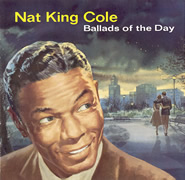A Pile o' Cole's Nat King Cole Website
Site Menu
Sings Ballads of the Day

Recorded January 14th 1953 - August 24th 1954
Released 1956
Nat Cole - Vocals, possibly Piano
Nelson Riddle - Arranger
* = Billy May - Arranger
Lee Gillette - Producer
Capitol T-680
- A Blossom Fell
- Unbelievable
- Blue Gardenia
- Angel Eyes*
- It Happens To Be Me
- Smile
- Darling, Je Vous Aime Beaucoup
- Alone Too Long
- My One Sin
- Return To Paradise
- If Love Is Good To Me
- The Sand And The Sea
"Time has made this album more evocative as a reflection of its day than it was when first issued, for those who can appreciate the qualities it captured."
At surface level, Ballads of the Day is a nice companion to Sings For Two In Love, presenting Nat King Cole the great ballad singer, again accompanied by arranger extraordinaire Nelson Riddle for all but one track, and reflecting Nat's great pop singles of this era more than any specific theme. This set is the lesser of the two, however, due to its inconsistency; such top Nat selections as A Blossom Fell and Angel Eyes are mixed with a few lesser-known and less spectacular pieces which nevertheless have the same qualities going for them. But its wider variety offers an attraction of its own.
Amid the lush early 1950's balladry and the elegance of the era which the packaging art evokes, the album also captures some of the ironic undercurrents of the day, perhaps or perhaps not all intentionally. Some of course have commented on the interesting situation Nat found himself in by this time, that of being able to serenade across social lines of race with a groundbreaking level of acceptance by the vast majority of all races. The idea of a white person being wooed aurally by a black person would have been thought somehow debasing at best by a majority of the white mainsteam in times past, and here was Nat hitting home runs in that very field. The quality of his music and person certainly figured promenintly in facilitating this situation, but the point here is that times were changing, and the ballads here are among those which featured in the day.
In addition to the straightforward songs like the oft-recorded, beloved Smile are an unusual number of songs showing the somewhat more exotic flair Nat's pop songs often took in those days. I've heard it suggested that exotic contexts made it more comfortable for white mainstream listeners to accept Nat, but I don't buy that theory at all. He was popular because he and his talents were appreciated and enjoyed by the vast majority of all races. The mild exotic flairs were something which enlivened the songs, and are far from surprising considering his breakthrough successes at pop balladry were exotic: Nature Boy and the seasonal The Christmas Song. Nat would have scored mainstream hits eventually with straight ballad fare regardless of race issues, but the exotic flair gave those songs an edge to listeners, signaling them out from the crowd, and that helped him establish himself in that genre. Most importantly, the exotic feel can aid in better expressing extraordinary and/or unfamiliar experiences. The poignant The Sand and the Sea and others with a slight exotic flair are carrying on that angle, but did so hand in hand with a straight ballad approach. This album showcases the resulting variety to be found in his popular songs of the era, all together in the same package, or same park to make a theme of the locale depicted on the cover.
Some have remarked upon the cover, showing Nat glancing knowingly over his shoulders at the lovers his songs serenaded, which on this cover as often in the case of listeners happened to be white, and its presentation of him walking though this elegant white lovers' setting (with equal elegance to my view of it). Just what that's supposed to be saying didn't impress itself upon me; but I did notice the dual persepctives of the listener being both the presumed purpose of the serenading, that couple in love, and being with Nat in his points of view, for Nat seldom sings "at" us as much as our listening participates in the music and lyric along with him. Therefore the accessable, active, personal expression we have illustrated, frontal and foreground, is Nat. What impressed me more was the choice of a romantic night setting for an album with "the day" in its title, how much better it suits the music and the contrasts of the somehow stormy sky with the closening lovers.
How much the selection of songs and aspects of the art were intentionally reflecting the Ballads of the Day I don't know, and I'm not sure it matters. The issues fade, and the times and fashions have changed for the music itself and the aspirations of beauty depicted in the cover's setting. Time has made this album more evocative as a reflection of its day than it was when first issued, for those who can appreciate the qualities it captured.